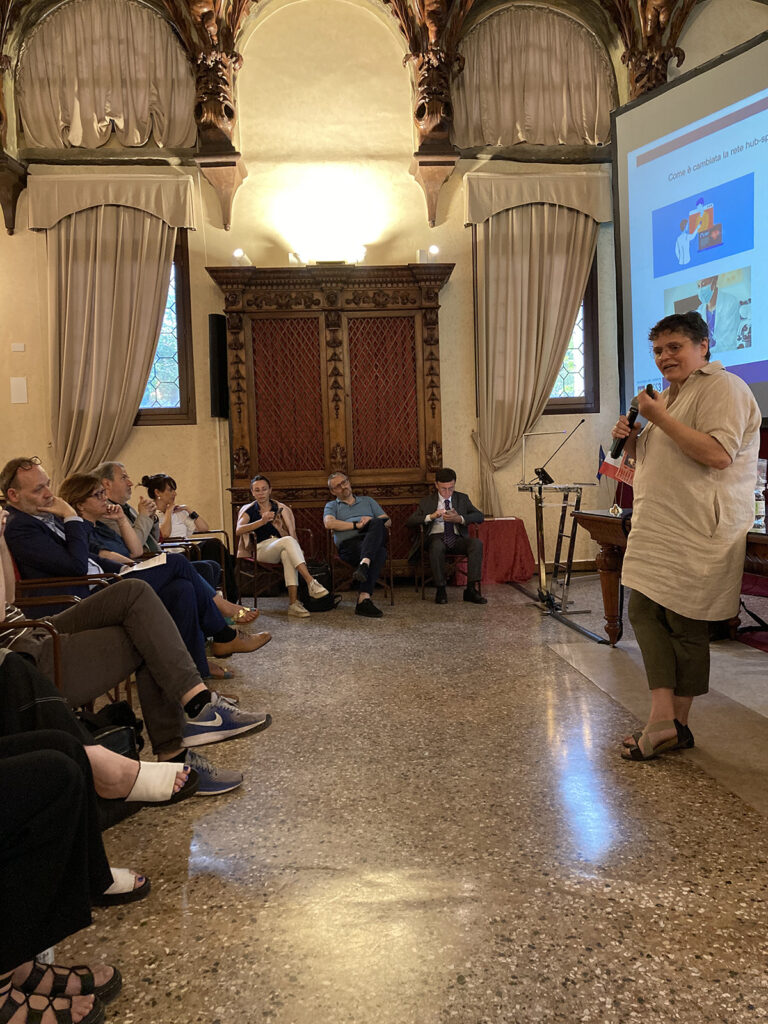Hubs and Spokes
The Veneto Region, uan example of an efficient healthcare network
Thursday 20 June, 18.45

Launched with Ministerial Decree 70, in line with other European models, the ‘hub and spoke’ model of the Italian National Health System (SSN) refers to both the management method of complex pathologies and the organisational system for the management of emergency medicine. It consists of a network of hospital facilities, that allows the most complex clinical practices to be concentrated in a limited number of centres (hubs), each of which are linked to peripheral centres (spokes). In its global design, the hospital network is divided into different pathology networks such as: IMA (heart attack) network, stroke network, trauma network, neonatal network and birth centres, oncology network, paediatric network, transplant network, pain therapy network, rare disease network. To create its own hub and spoke network, both structurally and organizationally, in recent years the Veneto Region has carried out a profound restructuring of its facilities such as the Ospedale dell’Angelo in Venice-Mestre.
This hub hospital was the first to be called into action when the emergency arose following the bus accident in Venice-Mestre in 2023, which could not be managed without the interaction of the surrounding spoke hospitals of Treviso, Dolo and Mirano. The basis for the efficient functioning of the system is the regional health planning that establishes which activities each hospital must carry out.
SPEAKERS
Alberto Altieri is one of the most experienced Italian architects working in the field of healthcare design, holding intellectual services contracts for highly specialised healthcare works, research laboratories, technological and scientific centres, care and assistance facilities for the elderly, disabled and handicapped. Active in the Veneto region, he has designed numerous hospitals in the region, including the Ospedale dell’Angelo in Venice-Mestre, which won the 2002 competition. Speaker at several international conferences and specialisation courses on the theme of complex buildings, he is a member of the faculty of the Master in Architettura e Salute, where he teaches architectural design for hospitals.
Luigi Antoniol is the Administrative Director of the Azienda ULSS 3 Serenissima (local healthcare service). Together with the General Director, he participates in the management of the local health service, in particular its programming, allocation and commissioning. He therefore contributes to the strategic planning process, providing mandatory opinions on acts relating to matters within its competence. He is a member of the faculty of the Master in Architettura e Salute, where he teaches healthcare management and the administration of right to health.
Chiara Berti is the director of the Ospedale dell’Angelo of Venice-Mestre and interim director of the organisational-managerial structure of the same facility. She graduated in Medicine specialising in Hygiene and Preventive Medicine (2000) and has built her career in the management of various hospital facilities and healthcare services in the Veneto region. She is a member of the faculty of the Master in Architettura e Salute, where her teaching focuses on patient pathways according to intensity of care in the hospital context.
Tommaso Caputo is the Director of the Technical and Asset Services UOC of the Azienda ULSS 6 Euganea in Padua. He graduated in Civil Engineering (1985) with a specialisation course, Design and Management of Hospital Buildings, in Bologna (1994) and, since 1988, has directed various offices and technical departments of healthcare services. A founding member of AIAST, which later merged into the National Council of SIAIS, he has participated as a speaker and moderator in several conventions and conferences on healthcare construction in various Italian cities.
Romina Cazzaro is Director of the Healthcare Planning Department of the Veneto Region and as such, since January 2024, she has been a Member of the Steering Committee for the Management of Outpatient Waiting Lists. She graduated in Medicine (2003), specialised in Hygiene and Preventive Medicine (2008) and graduated with a level II Master’s degree at the Polytechnic of Milan (2014), she has gained extensive experience in medical and healthcare management of various Aulss Veneto healthcare services, with several publications of articles and monographs and contributions to conferences.
Claudia Romero, architect, is coordinator of the healthcare section of Politecnica Ingegneria e Architettura. She is an expert both in functional planning of new generation hospitals and in the recommissioning of existing hospitals with a lean approach to organisational processes. Trained in interior design and the integration of medical equipment, Romero’s expertise ranges from fire safety, automation and micro-logistics to logistical-organisational and management issues.
Paolo Fattori is Director of the Hospital Construction Department for Collective Purposes of the Veneto Region. After graduating in Civil Engineering (2000), he specialised with a PM course at SDA Bocconi in Milan (2017) and a management training course for General Managers at Fondazione SSP in Padua (2021). He was the director of several public bodies and Aulss Veneto health facilities before being appointed director at the Regional Government (2018) where he works to enhance the Region’s healthcare, socio-health and social real estate assets. Since 2023, he has been following the progress of the Master in Architettura e Salute, considering it useful for the development of healthcare facilities in the Veneto region.
